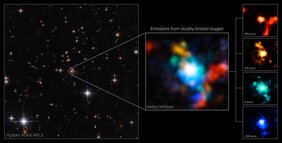While observing quasars with JWST a team of scientists under the lead of Dominika Wylezalek (ZAH/ARI) revealed a stunning cluster of galaxies in the process of formation. It's one of the densest known areas of galaxy formation in the early Universe.
Quasars are incredibly luminous cores of galaxies. Their brightness is powered by supermassive black holes sitting in their cores, causing a “galactic wind”, i.e. pushing gas out of the host galaxy and thereby influencing local star formation.
The quasar in question, known as SDSS J165202.64+172852.3 at a redshift of z=2.94, exists in the very early Universe, 11.5 billion years ago. In addition to its striking red colour, the galaxy’s light has been further shifted to the infrared by its huge distance and the expansion of the Universe. Therefore, the James Webb Space Telescope (JWST) with its outstanding infrared observing capabilities and imaging resolution was the ideal instrument to study in detail what's going on in this particular galaxy.
Previous studies already called attention to the quasar’s powerful outflows, and astronomers had speculated that its host galaxy merging with some unseen partner could actually be the cause for this activity. And indeed, Webb’s recent observations clearly indicated that not only one galaxy, but at least three more are swirling around in an extreme dense knot of galaxy formation.
"There are few galaxy protoclusters known at this early time. It’s hard to find them, and very few have had time to form since the Big Bang,” said astronomer Dominika Wylezalek of Center for Astronomy of Heidelberg University, who led the study into this quasar. “This may eventually help us understand how galaxies in dense environments evolve… It’s an exciting result."
The team suspects they could have been looking at the core of a cluster of galaxies revealed by Webb’s superb imaging and spectroscopic capability. This enabled them to map the motions of detectable objects, resulting in the conclusion that SDSS J165202.64+172852.3 was in fact part of a dense knot of galaxy formation.
Taking into account the speed at which three confirmed galaxies are orbiting and how closely they are packed into the region around the quasar, the team believes this marks one of the densest known areas of galaxy formation in the early Universe known so far. “Even a dense knot of dark matter isn’t sufficient to explain it,” Wylezalek says. “We think we could be seeing a region where two massive halos of dark matter are merging together.”
Dr Wylezalek’s team, which also includes postdoctoral researcher Dr. Caroline Bertemes from ARI/ZAH, is already planning follow-up observations into this galaxy proto-cluster to understand how dense, chaotic galaxy clusters like this one form, and how it’s affected by galactic winds and quasar feedback generated by the active, supermassive black hole at its heart.
This research was completed as part of Webb’s Early Release Science (ERS) Programs. These observations are taking place during the first 5 months of Webb science operations. The Webb observations that yielded this result were taken from the ERS program #1335.
ORIGINAL PUBLICATION
"First results from the JWST Early Release Science Program Q3D: Turbulent times in the life of a z=3 extremely red quasar revealed by NIRSpec IFU", Wylezalek D. et al., 2022, to be published in The Astrophysical Journal Letters (see https://arxiv.org/abs/2210.10074)
USEFUL LINKS
James Webb Space Telescope: https://esawebb.org/
Homepage of Dominika Weylezalek: https://wwwstaff.ari.uni-heidelberg.de/dwylezalek/
ADDITIONAL PRESS INFORMATION
Press release by ESA/NASA: https://esawebb.org/news/weic2217/
CONTACT FOR THE MEDIA
Dr Guido Thimm
Center for Astronomy at Heidelberg University
thimm@uni-heidelberg.de
SCIENTIFIC CONTACT
Dr Dominika Wylezalek
Center for Astronomy at Heidelberg University
Astronomisches Rechen-Institut
dominika.wylezalek@uni-heidelberg.de

